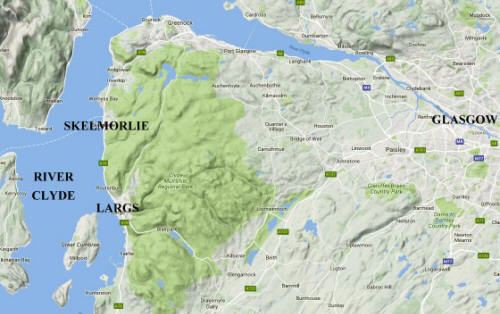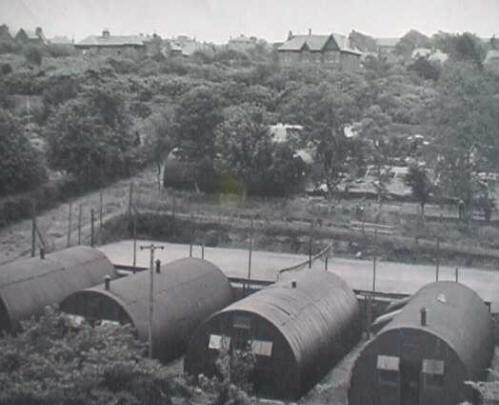|
HMS
COPRA
Combined Operations Pay Records & Accounts
 HMS Copra was a Royal Navy shore base
for the maintenance of personnel records and the calculation of pay and
allowances for RN personnel attached to Combined Operations. COPRA stands for
Combined Operations Pay Records & Accounts. HMS Copra was a Royal Navy shore base
for the maintenance of personnel records and the calculation of pay and
allowances for RN personnel attached to Combined Operations. COPRA stands for
Combined Operations Pay Records & Accounts.
[Map courtesy of Google Map Data 2017].
Background
HMS Copra had been established in Largs for several years when bank
clerk, Jean, volunteered for the WRNS and was posted to HMS Copra in the early months of 1945. In wartime, the military authorities had the power to requisition property in the national interest and the venue
selected for HMS Copra was 'The Moorings' - a pre-war shopping and
entertainment complex in the Ayrshire town of Largs. The building had a nautical look with
railings around the roof line and a flag pole prominently positioned in the superstructure. The accommodation used by
Copra, within
the complex, comprised a tea room, a ballroom and a cafe.
 The Work The Work
Around 300 Wrens and 300 Chief Petty Officers/Petty Officers were employed there. They worked in 15 sections, each
comprising around 20 Wrens and 20 CPOs and POs under the general command of a Captain and a Commander. Each section was headed by a Lieutenant
and was responsible for an alphabetical sequence of surnames.
Jean's section was responsible for 'K to L' and her 'Opo' was called 'Knobby' Hall.
[Photo; Wren. Jean Mathie. who served at HMS Copra
in the mid 1940s. Her recollections and photographs were invaluable in preparing
this account].
Each morning,
confirmation of new postings to Combined Operations and changes to existing postings
were received. Both of these changes to circumstances required pay
entitlements to be assessed or re-assessed. In essence, pay, once calculated, remained the same unless and until changes affecting entitlement
were received. Most common amongst these were changes in rank and postings.
Wrens selected for these
duties underwent a 3 week training course in Leeds. Those, like Jean, who were
high achievers in the course examination, were given the rank of Leading
Wren with a commensurate increase in pay. Jean recalled, "We were known as 'pay
writers' doing a job similar to a modern day wages clerk. We calculated the pay
due to the service personnel themselves while others were involved in
calculating the 'allotments' due to dependent relatives and in authorising payments
due. The going rate was 4 shillings and 9 pence, about 25p, plus 'grog'
(rum) money per day. The most difficult of cases, which required further
investigation, were handled by more senior ranks. most difficult of cases, which required further
investigation, were handled by more senior ranks.
Pay books did not pass through
Copra
as a general rule but, when they did, they were duly stamped to that effect.
However, the location of the actual posting of the RN personnel was also noted
in the book.
[Photo; Wrens hutted
camp at HMS COPRA, Largs. © IWM (A 29950)].
The working conditions in
The Moorings were pretty good. Our section sat about 20 or so each side of a
long table with the 'Opo' at the head. The room was open plan, well lit, warm
and the seating comfortable. We worked from 9 am to 5 pm Monday to Saturday and
9am to 12 noon on Sunday. One week in three we finished at 12 noon on the
Saturday."
The Billets
Wrens were billetted at the Skelmorlie Hydro Hotel about 6 miles north of Largs,
probably two or three to a room. In addition, there were 3 Jimmy the One huts in the grounds each accommodating 12 Wrens and a Chief Petty
Officer. A fourth Jimmy the One hut provided toilets and washing facilities.
The best accommodation, in the
hotel itself, was allocated on a first come first served bases. Jean, being a
late appointment, stood no chance of moving into the main building. Transport to
and from work was provided by RN buses and this included returning to the hotel
for lunch. In the evenings, 'liberty buses' provided a service to Largs, where
there were connecting service buses to other towns.
 The
Final Months The
Final Months
Jean continued to work at
HMS Copra until her marriage in June of 1946 when, as was normal in
those less enlightened times, her employment was terminated. HMS Copra
continued to function for another 6 months or so but finally closed as the mass
demobilisation came to an end. After the war, The Moorings resumed its pre-war
role but today the site is occupied by a complex of luxury flats and shops.
[Colourised Photo; The Skelmorlie Hydro Hotel].
Lt Cdr B Warlow's book 'Shore Establishments
of the Royal Navy' shows that parts of HMS Copra were located in
Southend and London as well as Largs as follows; Commissioned 30/8/43 at Chelsea
Court, London as Combined Operations pay and drafting office. Vacated on 3/8/44.
Copra (drafting) to Southend by 11/43 and to Largs by 5/10/45. Copra
(pay) at Largs by 3/8/44. Pensioned off 30/6/46.
'HMS Copra' is
sometimes noted on war graves in Normandy. Tony Chapman, Archivist and Historian of the LST
and Landing Craft Association explains,
HMS Copra, was never anything other than a shore base. I have the
names of many men recorded lost from HMS Copra because, sadly, the landing craft
they were serving on at the time of their deaths, was not recorded. The use of
HMS Copra on grave stones, in pay books and other service records confirms that
the men concerned were in the Royal Navy and assigned to Combined Operations
including crew members on landing
craft. I have the names of all the craft and ships assigned on D-Day and nowhere
is HMS Copra recorded as a vessel.
 Further Reading Further Reading
There are around 300 books listed on
our 'Combined Operations Books' page. They, or any
other books you know about, can be purchased on-line from the
Advanced Book Exchange (ABE). Their search banner link, on our 'Books' page, checks the shelves of
thousands of book shops world-wide. Just type in, or copy and paste the
title of your choice, or use the 'keyword' box for book suggestions.
There's no obligation to buy, no registration and no passwords.
[Colourised Photo; Working inside HMS Copra, Largs].
Acknowledgments
HMS Copra was a long forgotten RN shore base. Grateful thanks are due to
Mrs Jean Clark (nee Mathie) of Maybole, Ayrshire for providing information and
photographs and helping to preserve the memory of this important wartime naval
base.
|






